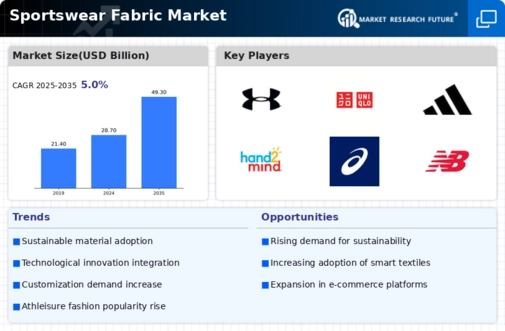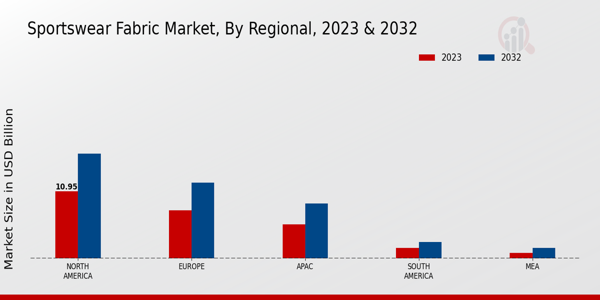Market Growth Projections
The Global Sportswear Fabric Market Industry is projected to experience substantial growth, with a market value of 28.7 USD Billion in 2024 and an anticipated increase to 49.3 USD Billion by 2035. This growth trajectory suggests a compound annual growth rate of 5.03% from 2025 to 2035, indicating a robust demand for innovative and high-performance fabrics. Factors such as rising health consciousness, technological advancements, and sustainability initiatives are likely to drive this expansion. The market's evolution reflects changing consumer preferences and the increasing importance of performance-oriented sportswear, positioning it as a dynamic sector within the broader textile industry.
Rising Health Consciousness
The increasing awareness of health and fitness among consumers is a primary driver for the Global Sportswear Fabric Market Industry. As individuals prioritize physical activity and wellness, the demand for high-performance sportswear fabrics that enhance comfort and functionality is growing. This trend is evident in the projected market value of 28.7 USD Billion in 2024, which reflects a shift towards materials that support active lifestyles. Brands are responding by innovating with moisture-wicking, breathable, and stretchable fabrics, catering to a diverse range of sports and activities. This heightened focus on health is likely to sustain growth in the sector.
Expansion of E-Commerce and Online Retail
The expansion of e-commerce and online retail platforms is reshaping the Global Sportswear Fabric Market Industry. As consumers increasingly turn to online shopping for convenience and variety, brands are adapting their distribution strategies to capitalize on this trend. The accessibility of sportswear fabrics through digital channels allows consumers to explore a wider range of products, fostering competition among manufacturers. This shift is likely to enhance market growth, as online retail provides valuable data on consumer preferences and trends, enabling brands to tailor their offerings effectively. The ongoing evolution of e-commerce is expected to play a pivotal role in the future of the sportswear fabric market.
Sustainability and Eco-Friendly Materials
Sustainability has emerged as a vital consideration in the Global Sportswear Fabric Market Industry. Consumers are increasingly favoring brands that prioritize eco-friendly materials and sustainable production practices. This shift is prompting manufacturers to explore recycled fabrics and biodegradable options, aligning with the growing demand for environmentally responsible products. The emphasis on sustainability is likely to influence purchasing decisions, as consumers become more aware of their ecological footprint. This trend may also drive innovation in fabric development, as companies strive to meet the expectations of a more environmentally conscious market, thereby enhancing their competitive edge.
Technological Advancements in Fabric Production
Technological innovations in fabric production are significantly influencing the Global Sportswear Fabric Market Industry. Advancements such as 3D knitting, smart textiles, and eco-friendly materials are revolutionizing how sportswear is designed and manufactured. These technologies not only improve the performance characteristics of fabrics but also address sustainability concerns, appealing to environmentally conscious consumers. The integration of smart textiles, which can monitor physiological parameters, is particularly noteworthy. As the market evolves, these advancements are expected to contribute to a compound annual growth rate of 5.03% from 2025 to 2035, indicating a robust future for technologically enhanced sportswear.
Growing Participation in Sports and Fitness Activities
The surge in participation in sports and fitness activities is a crucial driver for the Global Sportswear Fabric Market Industry. With more individuals engaging in recreational and competitive sports, the demand for specialized sportswear fabrics is on the rise. This trend is reflected in the anticipated market growth, reaching 49.3 USD Billion by 2035. As consumers seek apparel that enhances performance and comfort, manufacturers are increasingly focusing on developing fabrics that cater to various sports disciplines. This growing engagement in fitness not only boosts sales but also encourages innovation in fabric technology, further propelling market expansion.

























Leave a Comment